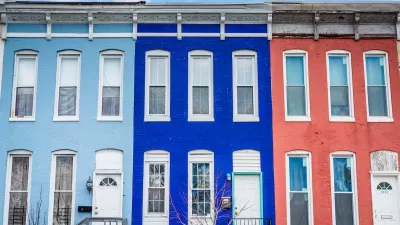Yepoka Yeebo reports on Baltimore's newest plan to deal with the tens of thousands of abandoned houses that mar the city.
Past efforts by Baltimore to raffle for $1, to demolish, and to refurbish the city's estimated 46,800 vacant houses and lots (16% of the city's housing stock) have proven unsuccessful. Now, the city it trying a new approach, ignoring most of them and focusing its limited funds on the most viable housing markets, writes Yeebo.
Yeebo spoke about the city's strategy change with Ira Goldstein, director of policy solutions at The Reinvestment Fund, who produced the assessment that Baltimore used to pinpoint stronger neighborhoods.
"'Too often, what we've done with the allocation of federal dollars cities get, is just find the poorest, most distressed place, and dump as much as you can in there, and see what happens,' he said. The results were weak, Goldstein explained, because the city would renovate houses no one wanted to buy. The money would be better-spent spurring interest in more attractive neighborhoods."
"As for the rest of the abandoned properties, where it can afford to, the city will still be dealing with the most dangerous structures. Eventually, the plan calls for demolishing the most distressed housing, and holding onto the land until there's scope for large-scale development," explains Yeebo.
FULL STORY: Baltimore Decides Some Neighborhoods Just Aren’t Worth Saving

Alabama: Trump Terminates Settlements for Black Communities Harmed By Raw Sewage
Trump deemed the landmark civil rights agreement “illegal DEI and environmental justice policy.”

Study: Maui’s Plan to Convert Vacation Rentals to Long-Term Housing Could Cause Nearly $1 Billion Economic Loss
The plan would reduce visitor accommodation by 25% resulting in 1,900 jobs lost.

Why Should We Subsidize Public Transportation?
Many public transit agencies face financial stress due to rising costs, declining fare revenue, and declining subsidies. Transit advocates must provide a strong business case for increasing public transit funding.

Paris Bike Boom Leads to Steep Drop in Air Pollution
The French city’s air quality has improved dramatically in the past 20 years, coinciding with a growth in cycling.

Why Housing Costs More to Build in California Than in Texas
Hard costs like labor and materials combined with ‘soft’ costs such as permitting make building in the San Francisco Bay Area almost three times as costly as in Texas cities.

San Diego County Sees a Rise in Urban Coyotes
San Diego County experiences a rise in urban coyotes, as sightings become prevalent throughout its urban neighbourhoods and surrounding areas.
Urban Design for Planners 1: Software Tools
This six-course series explores essential urban design concepts using open source software and equips planners with the tools they need to participate fully in the urban design process.
Planning for Universal Design
Learn the tools for implementing Universal Design in planning regulations.
Smith Gee Studio
Alamo Area Metropolitan Planning Organization
City of Santa Clarita
Institute for Housing and Urban Development Studies (IHS)
City of Grandview
Harvard GSD Executive Education
Toledo-Lucas County Plan Commissions
Salt Lake City
NYU Wagner Graduate School of Public Service





























